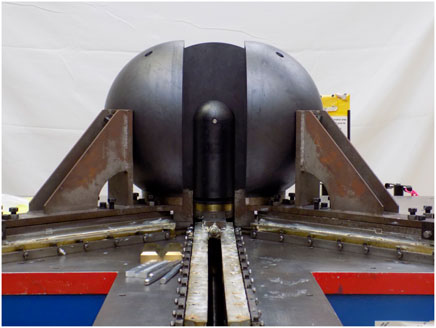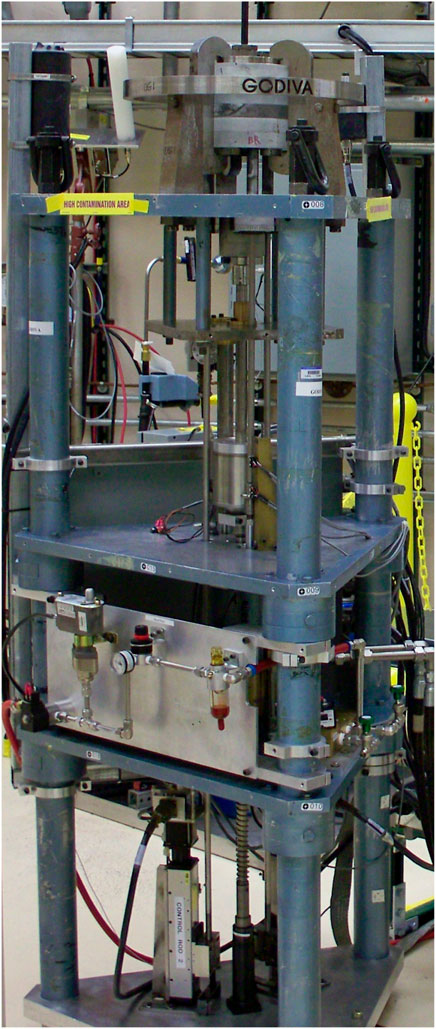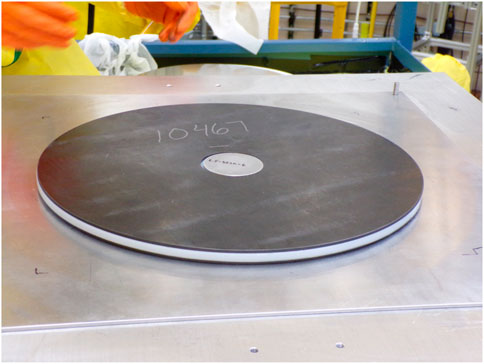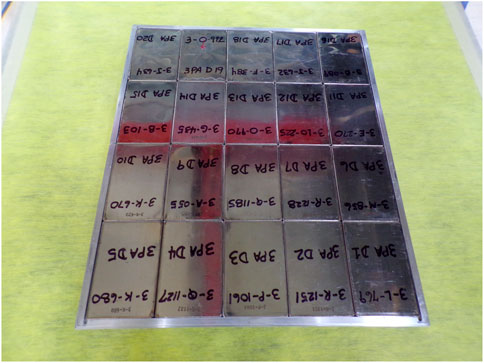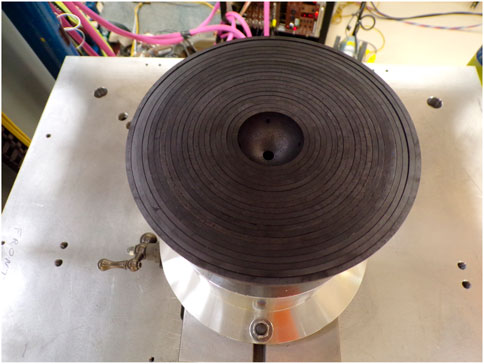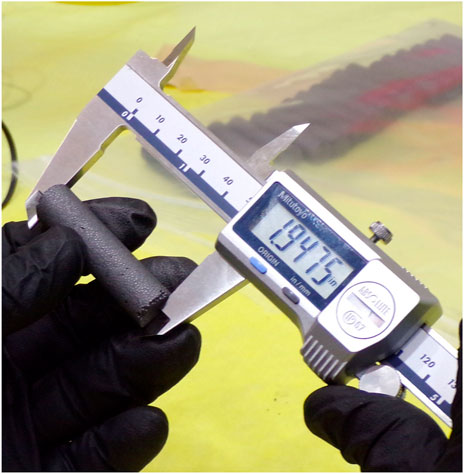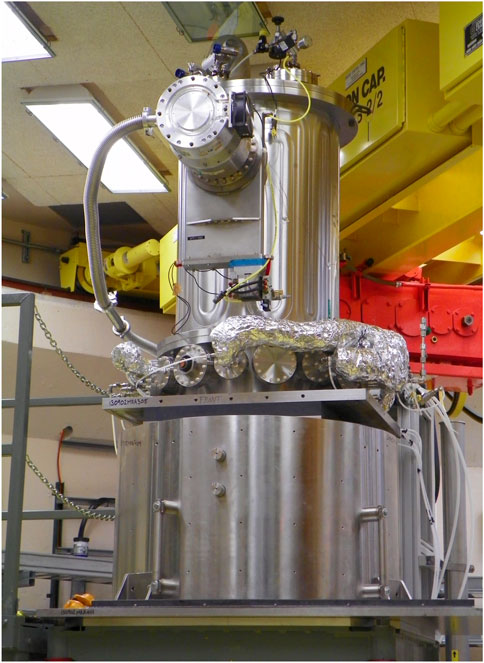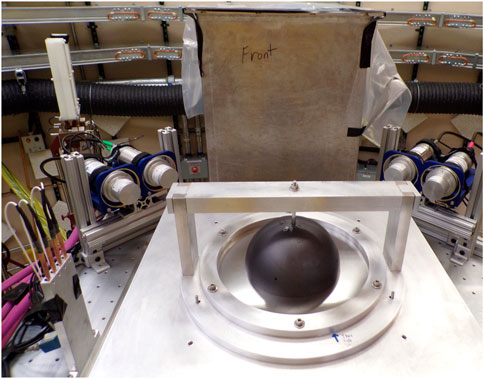- 1Los Alamos National Laboratory, Nuclear Engineering and Nonproliferation, Advanced Nuclear Technology (NEN-2), Los Alamos, NM, United States
- 2Los Alamos National Laboratory, Nuclear Engineering and Nonproliferation Systems Design and Analysis (NEN-5), Los Alamos, NM, United States
- 3Los Alamos National Laboratory, Civilian Nuclear Programs, Los Alamos, NM, United States
- 4Los Alamos National Laboratory, Materials Science and Technology, Materials Science in Radiation and Dynamics Extremes (MST-8), Los Alamos, NM, United States
The National Criticality Experiments Research Center (NCERC) located at the Nevada National Security Site (NNSS) in the Device Assembly Facility (DAF) and operated by Los Alamos National Laboratory (LANL) is the only general purpose critical experiments facility in the United States. Experiments from subcritical to critical and above prompt critical are carried out at NCERC on a regular basis. In recent years, NCERC has become more involved in experiments related to nuclear energy, including the Kilopower/KRUSTY demonstration and the recent Hypatia experiment. Multiple nuclear energy related projects are currently ongoing at NCERC. This paper discusses NCERC’s role in advanced reactor design and how that role may change in the future.
1 Introduction
The National Criticality Experiments Research Center (NCERC) located at the Nevada National Security Site (NNSS) in the Device Assembly Facility (DAF) and operated by Los Alamos National Laboratory (LANL) is the only general purpose critical experiments facility in the United States. NCERC consists of four critical assemblies; Comet, Planet, Flattop, and Godiva IV. Using these critical assemblies and the large quantities of nuclear materials stored at NCERC, an almost limitless combination of experiments can be performed.
NCERC has its roots in the Manhattan Project at the Pajarito Site and later TA-18, both at LANL (Loaiza and Gehman, 2006; Hutchinson et al., 2021a). For decades, criticality experiments were performed at LANL, known as the Los Alamos Critical Experiments Facility (LACEF) (Paxton, 1978, Paxton, 1981, Paxton, 1983). In the early 2000s, some of the critical assemblies were moved out to NNSS to the DAF and reconstituted as NCERC. For over 10 years since that move, criticality experiments have been performed at NCERC. This also includes many subcritical experiments. These experiments have been documented in a special issue of Nuclear Science and Engineering (Hutchinson et al., 2021b; Thompson et al., 2021b; Goda et al., 2021; Hayes et al., 2021; Sanchez et al., 2021).
1.1 Criticality experiments
Criticality experiments are experiments where fissile material is arranged in a way that generates meaningful and measurable neutron multiplication. These experiments can be a subcritical bare sphere of material or can scale all the way up to a full scale demonstration of a reactor. Criticality experiments are typically low power (a few kW and below), although burst experiments can have instantaneous powers of many GW for a very short amount of time. A typical criticality experiment is used to measure the reactivity of the system or other nuclear parameters. At NCERC, we often use the term “criticality experiments” over “critical experiments” as “critical” implies a keff of 1.0, whereas the experiments we perform can range from very subcritical to critical and above prompt supercritical. Each of the critical assemblies at NCERC use different means of reactivity control and various detectors so that important parameters such as reactivity and delayed critical configurations can be measured with high accuracy.
The main sponsor for NCERC experiments is the Nuclear Criticality Safety Program (NCSP). NCERC (and LACEF before that) has performed many benchmark critical and subcritical experiments which are now part of the International Criticality Safety Benchmark Evaluation Project handbook (ICSBEP) (OECD-NEA, 2022). The ICSBEP benchmarking process is extremely rigorous; each benchmark includes dimensions of each component, material compositions, temperature information, isotopics for fuel and other relevant components, and uncertainties for each of these values. These uncertainties are used to estimate the uncertainty in the experiment, the uncertainty in the benchmark model, and biases between the experiment and benchmark model. Due to their high quality, these benchmarks are crucial for validating nuclear data and ensuring nuclear criticality safety. Major nuclear data libraries such as ENDF/B-VIII.0, JEFF-3.3, and JENDL-4.0 make extensive use of criticality benchmarks for validating nuclear data and benchmarking the performance of the nuclear data library compared to other libraries (van der Marck, 2006, 2012; CHIBA et al., 2011; SHIBATA et al., 2011; Brown et al., 2018; Plompen et al., 2020). In fact, nuclear data libraries are sometimes adjusted to match these benchmarks, for example, nubar for 239Pu and 235U respectively were adjusted to match keff of Jezebel and Godiva in ENDF/B-VIII.0 (Peterson, 1953; Peterson and Newby, 1956; LaBauve, 2002; Favorite, 2016; Brown et al., 2018; Chadwick et al., 2018; Kimpland et al., 2021).
Recently, NCERC has performed a number of experiments related to nuclear energy and advanced reactors, some of which will be covered in Section 4. Given NCERC’s unique capabilities, experiments can be performed on relatively accelerated timelines, and often without major changes to the facility. This allows NCERC to fill an interesting niche for performing criticality testing on fuels and components, and even small scale, low power demonstrations of advanced reactor designs.
2 NCERC capabilities
NCERC has four critical assemblies, Planet, Comet, Flattop, and Godiva IV. Planet and Comet are vertical lift assemblies, meaning a portion of the reactor is placed on a lower, movable platen, while another portion is affixed to a stationary platform above. When the lower platen is inserted, reactivity of the system is increased and a critical experiment can be conducted. Figures 1, 2 show photos of the Planet and Comet assemblies respectively. Comet has a much higher lifting capacity and overall weight limit than Planet, so much of this paper will focus on the Comet assembly.
Flattop has a highly enriched uranium (HEU) or weapons grade Pu spherical core, surrounded by one metric ton of natural uranium, which is split into a stationary hemisphere and two movable quarter spheres. The stationary hemisphere also has control rods made of natural uranium which can be inserted to increase reactivity. Flattop is primarily used for activation analyses and as a training tool. Figure 3 is a photo of the Flattop assembly.
Godiva IV is a fast burst assembly made of HEU. It has a cylindrical core with roughly 65 kg of HEU and is used for many experiments, including testing criticality accident alarm system, measuring prompt fission neutron spectrum, and activation analyses. Figure 4 is a photo of the Godiva IV assembly.
NCERC also has a large selection of fuels. The most commonly used are the HEU “Jemima” plates (so named due to their pancake like shape) and the Pu Zero Power Physics Reactor (ZPPR) plates. Figures 5, 6 show photos of the Jemima plates and ZPPR plates. The ZPPR plates came from the original ZPPR which was located at Idaho National Laboratory (Shuck et al., 1967). NCERC also has other materials, including the “Rocky Flats Shells”, HEU hemi-shells which were produced at the Rocky Flats plant (seen in Figure 7) (Rothe, 2005, Rothe, 2003), the HEU “C-Disks” (Brewer, 1998) (used in the SPEC-MET-FAST-004 benchmark and the Hypatia experiment discussed in Section 4.2, seen in Figure 8), and the Compact Nuclear Power Source (CNPS) fuel (Hansen and Palmer, 1989). The CNPS experiment used high-assay low enriched uranium (HALEU) Tri-structural Isotropic (TRISO) fuel, making NCERC one of the few facilities in the world with appreciable amounts of HALEU TRISO fuel. Figure 9 shows an example of one of the CNPS HALEU TRISO fuel compacts.
There are a number of detector systems that are used during experiments at NCERC. These include startup (He3) and linear channel (compensated ion chambers) detectors for monitoring neutron flux, organic and inorganic scintillators for measuring neutron and gamma responses, and many other detectors. These other systems are used for gamma spectroscopy, neutron noise measurements, neutron leakage spectra measurements, and others. In addition to the critical assemblies, NCERC also has a count room that is routinely used for counting irradiated samples from NCERC measurements. This includes HPGe detectors, alpha spectroscopy equipment, and dosimetry equipment for determining dose.
3 Nuclear criticality safety
Many of the experiments performed at NCERC are funded by NCSP. These experiments usually focus on one material (e.g., nickel or iron) or one application (e.g., Hanford waste tanks). In the case of a material, there is often a specific concern about nuclear data. One example of this is the upcoming CERBERUS experiment which is designed to be highly sensitive to copper cross sections in the 100 keV–900 keV energy region (Amundson et al., 2022). The end goal of this experiment is to validate copper cross sections which will help improve existing benchmarks that are sensitive to copper, particularly the Zeus benchmarks. The Zeus experimental series were the first to use the large copper reflector on the Comet critical assembly, and these benchmarks are used often in validating nuclear data (Mosteller et al., 2004; Mosteller, 2005; Hayes and Sanchez, 2006).
In cases where an experiment is designed to match an application, the experiment is designed to match the sensitivity profile of the application, using tools such as the particle transport code MCNP®1 (Werner et al., 2017) and the sensitivity/uncertainty analysis code WHISPER (Kiedrowski et al., 2015). MCNP can be used to generate sensitivity profiles, and the WHISPER code can then compare those profiles to existing benchmarks or applications, generating similarity coefficients for each benchmark based on the “sandwich rule.” Much more has been written and published about this topic and code. Both of these methodologies (designing to test a material or designing to match an application) are extremely relevant for advanced reactors.
4 Selection of relevant past experiments
NCERC has performed a number of recent experiments that are highly relevant to advanced reactors, below are just a sample.
4.1 KRUSTY/Kilopower
In 2012, the Demonstration Using Flattop Fission (DUFF) experiment was performed (Poston, 2013). This experiment used the Flattop assembly with a heatpipe inserted in the center of the core attached to a Stirling engine. This experiment was the predecessor to the KRUSTY/Kilopower experiment, which was performed in late 2017 and early 2018.
The KRUSTY/Kilopower experiment was a demonstration of a space nuclear reactor being developed with NASA. The experiment itself was a collaboration between NASA, NCSP, and NNSA. The motivation was to ensure high reliability by minimizing moving parts as much as possible, while also maximizing the power to weight ratio. The final experiment used an HEU core about the size of a roll of paper towels, surrounded by a BeO reflector, on the Comet critical assembly (seen in Figure 10). The HEU core was new and designed specifically for this experiment and manufactured at Y-12. Eight heatpipes were also connected to the core, which were cooled by Stirling engines and simulated Stirling engines. To simulate space conditions, the core, heatpipes, and Stirling engines were enclosed in a large vacuum chamber.
Weeks of tests were performed to bring the system critical and measure reactivity of components. The final test included a 28 h “high power” test, averaging 3 kW of power and an average core temperature of 800°C while undergoing many transients (startup, loss of cooling, reactivity insertions, shutdown, etc.). These tests showed the capability for the system to load-follow (match power to a desired electrical load) with no operator input. Much more has been written about this experiment in a special issue of Nuclear Technology, along with other publications (McClure et al., 2020b; Poston et al., 2020a; Gibson et al., 2020; McClure et al., 2020a; Sanchez et al., 2020; Grove et al., 2020; Poston et al., 2020b, Poston et al., 2020c; Stolte et al., 2022). The KRUSTY experiment has been approved and has been included as a benchmark in the 2021 ICSBEP Handbook and will be useful for validating Be nuclear data.
4.2 Hypatia
Hypatia was an experiment conducted in early 2021 that was focused on performing a heated critical experiment with yttrium-hydride (YHx). YHx has been proposed by many as a potential neutron moderator in micro-reactors, due to its high hydrogen density and low hydrogen loss even at high temperatures (Trellue et al., 2021). However, until the Hypatia experiment, there had never been a critical experiment performed with YHx.
There was a large effort at LANL to develop YHx samples large enough to work in a critical experiment (Trellue et al., 2022). Once the YHx samples were produced, they were sealed and shipped to NCERC. The Hypatia core was a combination of HEU disks (C-Disks), graphite pieces, electric heaters, and YHx samples, all surrounded by Be as a reflector and moderator.
During this test, the YHx samples were heated to roughly 300°C and reactivity was measured as a function of temperature. This was the first experiment to demonstrate and measure the positive temperature coefficient of reactivity for YHx, meaning that as the temperature of the YHx increased, the reactivity also increased. This effect has been seen before in ZrHx in the Topaz reactor (Buden, 1993), and was predicted based on new thermal scattering laws for YHx in ENDF/B-VIII.0 (Zerkle and Holmes, 2017; Zerkle et al., 2021; Brown et al., 2018) and new experimental data on YHx scattering (Mehta, 2020; Mehta et al., 2022). The positive temperature coefficient of reactivity for YHx may have design implications for advanced reactors seeking to utilize this moderator (Ade et al., 2022). Additional information on the Hypatia experiments can be found in publications by Trellue and Cutler (Trellue et al., 2021, Trellue et al., 2022; Cutler et al., 2022b).
4.3 MUSiC
The Measurement of Uranium Subcritical and Critical (MUSiC) experiment was performed in 2020 and 2021 at NCERC using the “Rocky Flats Shells” (McSpaden et al., 2019a; Weldon et al., 2021, Weldon et al., 2020; Darby et al., 2021; McSpaden et al., 2021). Figure 11 is a photo of the experimental setup. The goal of the experiment was to perform high quality measurements of HEU systems with many detector types, from very subcritical to critical. Since the Rocky Flats Shells are nesting HEU hemishells, systems of different size spheres of HEU were made by varying which shells were used in the experiment. The MUSiC experiment included some measurements with a252Cf source, some with a pulsed deuterium-tritium neutron generator, and some with no external neutrons. Similar subcritical measurements are often made at NCERC, but this was the first time at NCERC a system like this was measured from subcritical to critical. Two MUSiC critical experiments will be submitted as benchmarks to the ICSBEP Technical Review Group in 2023. Other subcritical experiment benchmarks will follow in the years to come. Ultimately, this data will be used by nuclear data evaluators to validate 235U nuclear data in the fast energy region, which is extremely important for many advanced reactor designs. Additionally, due to uncertainties in the original “Lady Godiva” benchmark, MUSiC may become the new standard for 235U validation (Bess et al., 2013; Hutchinson et al., 2022b).
4.4 Japan Atomic Energy Agency collaboration experiments
From 2015 to 2019, a series of experiments in collaboration with the Japan Atomic Energy Agency (JAEA) was performed, specifically focused on lead void coefficients of reactivity. The JAEA was interested in created an Accelerator Driven System (ADS) for spent fuel transmutation. Three configurations were built and operated, a Plutonium system (also known as Jupiter), an HEU system, and an effectively Intermediate Enriched Uranium (IEU) system (Fukushima et al., 2018, Fukushima et al., 2019). The “IEU” system combined natural and HEU Jemima plates to create an “effective enrichment” of 22.9 weight percent. Each of the systems had a large amount of lead (Pb), and multiple experiments were performed where the amount of lead in the system was varied while keeping the fuel concentration constant. This allowed for measurements of the void coefficient of reactivity of lead for each system. The HEU/Pb and IEU/Pb systems used the Jemima plants for fuel, and the Pu system (Jupiter) used ZPPR plates. There was also a Jupiter configuration which utilized ZPPR plates with higher 240Pu content. The HEU/Pb system had a negative lead void coefficient of reactivity, but the IEU/Pb had a positive lead void coefficient; this behavior was predicted in MCNP simulations, but it highlights the importance of demonstration experiments to prove that models are performing correctly (Goda et al., 2015; Goda et al., 2019, Thompson et al., 2021b). Work is ongoing to submit these experiments to the ICSBEP as benchmarks (McSpaden et al., 2019b, McSpaden et al., 2020; Amundson et al., 2020).
5 Upcoming NCERC experiments
NCERC also has some upcoming experiments that are highly relevant to advanced reactor development and deployment.
5.1 EUCLID
Experiments Underpinned by Computational Learning for Improvements in Nuclear Data (EUCLID) is a LANL Laboratory Directed Research & Development project focused on identifying and resolving compensating errors in nuclear data (Hutchinson et al., 2022a; Neudecker et al., 2022a; Neudecker et al., 2022b; Clark et al., 2022; Kleedtke et al., 2022; Rising and Clark, 2022). As part of this project, an experiment series at NCERC was designed using machine learning tools. This experiment was specifically focused on 239Pu scattering using two different configurations: one that maximizes neutron leakage, and one that minimizes leakage. Because of the large differences in leakage, there are large differences in sensitivities to both elastic and inelastic scattering. Even for a well known isotope such as 239Pu, different nuclear data libraries (ie. ENDF/B-VIII.0 and JEFF-3.3) have very different 239Pu elastic and inelastic scattering cross sections. This experiment should assist in resolving some of the issues between nuclear data libraries for 239Pu and this methodology of experiment design will be used for other experiments in the future.
5.2 Westinghouse eVinci
NCERC is currently partnering with Westinghouse to potentially perform a small scale demonstration of their eVinci microreactor. A portion of the eVinci core will be placed on the movable platen of Comet, and surrounded by graphite fueled with the CNPS fuel. The setup will be designed to accommodate measurements in the temperature range of 20–1,200°C and will contain materials to be tested. The current plan includes 1/M approach to criticals for the different configurations, component critical tests (testing reactivity of various components), and heated tests with various core configurations. This data will be used by Westinghouse to validate their simulation codes, reduce uncertainties, and to help support their safety case to their regulator. It is to be determined whether this data will stay proprietary or will become an official benchmark in the ICSBEP or IRPhEP handbooks (OECD-NEA, 2022, OECD-NEA, 2019).
6 NCERC and advanced reactors
As demonstrated from the experiments mentioned above, there are two key ways experiments at NCERC can support the development and deployment of advanced reactors - through low power demonstrations, and experiments designed to validate key nuclear data.
6.1 Low power demonstrations
The KRUSTY/Kilopower experiment summarized in Section 4.1 is a great example of a low power demonstration that can be performed at NCERC. However, one downside to the KRUSTY experiment was neutron activation; even with shielding around the core, the room remained unusable for other experiments for months. Given the high demand for the NCERC facility, being unable to operate key critical assemblies for over a month is not currently an option. As a lesson learned from KRUSTY, experiments in the future will have to be lower power, which often necessitates electric heating as opposed to nuclear heating.
There is still an enormous amount of information that can be gained from low power demonstrations, such as reactor physics parameters, system reactivity, reactivity of components, temperature coefficients, flux distributions, neutron spectra via activation foils, leakage spectra, multiplicity, shielding performance, control rod/drum worth, and much more. These are exactly the types of measurements being planned for the Westinghouse eVinci demonstrations.
Today many of these parameters are simulated without adequate validation data, especially for novel systems such as advanced reactors that often plan to use new coolants, fuels, moderators, or other materials. Additionally, there are even fewer validation experiments at the high temperatures many of these reactors are planning to operate at. It is important we make high quality measurements of these systems and materials so that when these systems are actually built, they operate as they are designed.
6.2 Nuclear data
Nuclear data is extremely important for advanced reactors, and in some cases, the quality of the nuclear data today is still lacking. One rather important example that has gotten a lot of attention is the 35Cl (n,p) cross section at high energies. As was shown by Oak Ridge National Laboratory, TerraPower, and Moltex Energy, the 35Cl (n,p) has a huge impact on the reactivity of Molten Chloride Fast Reactors (Bostelmann et al., 2020; Kolos et al., 2022; Taylor et al., 2022). In fact, changes in recent nuclear data libraries have resulted in differences of thousands of pcm. Additionally, uncertainty/covariance data for 35Cl (n,p) in ENDF/B-VIII.0 is missing above ∼1 MeV, meaning some analysis techniques which rely on covariance data to estimate nuclear data uncertainties will not attribute any nuclear data uncertainty to this reaction. In this way, covariances can be just as important as the underlying cross sections. This topic has already generated multiple papers and a request to the NEA Nuclear Data High Priority Request List.
This is an example of a material and energy range that could be targeted with a well designed critical experiment at NCERC. In fact, NCERC recently completed the Chlorine Worth Study (CWS) experiment (Cutler et al., 2022a) - this experiment was focused on the reactivity worth of chlorine at low energies, specifically related to aqueous chloride operations. While this CWS experiment is not very helpful for validating the 35Cl (n,p) cross section in the fast energy region, another measurement could be designed to test just that. As was mentioned before, many experiments at NCERC are designed specifically to validate nuclear data.
Another relevant example of an experiment designed to validate nuclear data is the Critical Unresolved Region Integral Experiment (CURIE). CURIE was originally designed to validate the unresolved resonance region (URR) of 235U (Cutler et al., 2018). Around the same time CURIE was taking place, the Nuclear Data Machine Learning team lead by Denise Neudecker at LANL found some rather large discrepancies in nuclear data for 19F (Neudecker et al., 2020). CURIE used the large copper reflectors form ZEUS and teflon (PTFE) moderator plates to create an energy spectrum highly sensitive to the URR of 235U, making CURIE also highly sensitive to 19F in this energy region (Cutler et al., 2020; Thompson et al., 2021a). Because of this, CURIE is currently being used by members of the Cross Section Evaluation Working Group (CSEWG) and the International Nuclear Data Evaluation Network (INDEN) to validate and improve 235U, 19F, and 63,65Cu nuclear data (Trkov and Capote, 2022). Work is ongoing to submit this experiment as an ICSBEP benchmark.
Many other experiments have been performed at NCERC specifically focused on nuclear data validation, including the TEX HEU and TEX Pu series, the Zeus series, and others (Percher and Norris, 2019; Percher and Norris, 2020, Norris and Araj, 2021; Mosteller et al., 2004; Mosteller, 2005; Hayes and Sanchez, 2006). These experiments are detailed in the NCERC Ten Year Papers and other publications (Hutchinson et al., 2021b; Thompson et al., 2021b; Goda et al., 2021; Hayes et al., 2021; Sanchez et al., 2021).
7 Future of NCERC
Recently at LANL, a meeting was held to discuss the future of NCERC, aptly named NCERC Futures. A report on the meeting is currently being written, but many ideas for new buildings/facilities, critical assemblies, measurements, and fuels were presented. One notable mention here is the possibility of adding a horizontal split table to NCERC. This would add the capability to perform much larger experiments at NCERC. Currently experiments are limited by the size and weight limits of the Comet assembly. A horizontal split table would have a much larger area for experiments and a much larger weight limit, which would allow for experiments similar to the ones done at the original ZPPR (near full scale reactor experiments). It should be noted that LACEF previously had multiple horizontal split table reactors, “Big Ten,” which operated intermittently from 1971 to 1996 and “Honeycomb” which operated from 1956 to 1990 (Loaiza and GehmanPaxton, 2006; Paxton, 1983).
Other notable mentions include a new Jezebel (unreflected Pu system), another Comet assembly, and new fuels such as Pu nesting hemishells. Many of these new assemblies would require NCERC to expand into a new building: this is currently being investigated.
8 Conclusion
NCERC can play a crucial role in supporting the development and deployment of advanced reactors. Small scale demonstrations can be built and tested. Key nuclear data parameters can be measured and validated. NCERC has done many experiments in the past that have helped to constrain important nuclear data.
NCERC has also performed demonstrations of advanced reactors, and experiments are currently in the planning process to perform additional demonstration experiments. Since NCERC is a low power facility, experiments can often be done much faster and cheaper than it would cost to build a full scale demonstration, while providing much of the same experimental data. The future is bright for advanced reactors as long as experimental facilities like NCERC are open to perform crucial experiments to demonstrate reactor designs, demonstrate key nuclear physics, and validate nuclear data.
Author contributions
NT wrote most of the article, is the PI of the Westinghouse eVinci project, and is part of the NCERC team. AM is a member of the Westinghouse eVinci team at LANL, specializing in neutronics and thermal analysis, and also helped write the article. TC was the NCERC lead on the Hypatia experiment and the Chlorine Worth Study. HT managed the Hypatia experiment and also leads other advanced reactor and micro-reactor activities at LANL. VD is the head of the Civilian Nuclear Program office at LANL and has been involved in both the Hypatia and Westinghouse projects. CM is involved in managing all technical projects with Westinghouse. JG is the NCERC team leader, and is also the PI for the Godiva assembly. DH is the NCERC Chief Engineer, the PI for Flattop, and has been involved in nearly every experiment performed at NCERC since its founding. RS is the PI on the Comet and Planet assemblies, was the NCERC lead on the KRUSTY/Kilopower experiment, and has also been involved in nearly every project at NCERC since its founding. KA, TG, JH, HK, CK, JL, GMcK, GMcM, AM, KS, JW, RW, and NW are all members of the NCERC team and have worked on many of the projects mentioned in this article. All of the authors gave comments and suggestions for the article.
Funding
This work was supported by the U.S. Department of Energy through the Los Alamos National Laboratory. Los Alamos National Laboratory is operated by Triad National Security, LLC, for the National Nuclear Security Administration of U.S. Department of Energy (Contract No. 89233218CNA000001). Much of the work discussed was supported by the DOE Nuclear Criticality Safety Program, funded and managed by the National Nuclear Security Administration for the Department of Energy. Other sources of funding include the Los Alamos National Laboratory Laboratory Directed Research and Development Program, NASA, and DOE-NE.
Acknowledgments
The authors would like to acknowledge the technicians of NCERC, Kenny Valdez and Justin Martin in particular, for their tireless help getting these experiments up and running. The authors would also like to thank NCERC-FO for their support of NCERC activities, the RCTs at NCERC for constantly ensuring our safety and minimizing our contamination while working with hazardous materials. A special thanks to the NEN-2 Design Engineering team for making these experiments a reality. The authors would also like to thank the NEN management for their forward thinking an openness to expanding NCERC activities and scope.
Conflict of interest
The authors declare that the research was conducted in the absence of any commercial or financial relationships that could be construed as a potential conflict of interest.
Publisher’s note
All claims expressed in this article are solely those of the authors and do not necessarily represent those of their affiliated organizations, or those of the publisher, the editors and the reviewers. Any product that may be evaluated in this article, or claim that may be made by its manufacturer, is not guaranteed or endorsed by the publisher.
Footnotes
1MCNP® and Monte Carlo N-Particle® are registered trademarks owned by Triad National Security, LLC, manager and operator of Los Alamos National Laboratory. Any third party use of such registered marks should be properly attributed to Triad National Security, LLC, including the use of the designation as appropriate. For the purposes of visual clarity, the registered trademark symbol is assumed for all references to MCNP within the remainder of this paper.
References
Ade, B. J., Betzler, B. R., Burns, J. R., Chapman, C. W., and Hu, J. (2022). Reactor physics considerations for use of yttrium hydride moderator. Nucl. Sci. Eng. 0, 1–20. doi:10.1080/00295639.2022.2035157
Amundson, K., Cutler, T., and Thompson, N. (2022). “CERBERUS integral experiment design,” in Proceedings of the nuclear criticality safety division topical meeting (NCSD 2022), Anaheim, CA, June 12–16, 2022, 305–314. Available at: https://www.ans.org/pubs/proceedings/article-51948
Amundson, K., et al. (2020). Fast-spectrum critical assemblies with a pb-heu core surrounded by a copper reflector. Trans. Am. Nucl. Soc. 123, 817.
Bess, J., Briggs, J., and Marshall, M. (2013). “What if lady Godiva was wrong?” in International conference on nuclear data for science and Technology. ND 2013).
Bostelmann, F., Ilas, G., and Wieselquist, W. A. (2020). Key nuclear data impacting reactivity in advanced reactors. Oak Ridge, TN: Oak Ridge National Laboratory. Tech. Rep. ORNL/TM-2020/1557. doi:10.2172/1649145
Brewer, R. (1998). “Critical experiments performed using plate of plutonium-242, HEU, and plutonium-239,” in International handbook of evaluated criticality safety benchmark experiments (Paris: OECD Nuclear Energy Agency).
Brown, D., Chadwick, M., Capote, R., Kahler, A., Trkov, A., Herman, M., et al. (2018). ENDF/B-VIII.0: The 8th major release of the nuclear reaction data library with CIELO-project cross sections, new standards and thermal scattering data. Nucl. Data Sheets 148, 1–142. doi:10.1016/j.nds.2018.02.001
Buden, D. (1993). Summary of space nuclear reactor power systems. Tech. Rep. INEL/MISC-93085 Available at: https://www.osti.gov/biblio/10151265.
Chadwick, M., Capote, R., Trkov, A., Herman, M., Brown, D., Hale, G., et al. (2018). CIELO collaboration summary results: International evaluations of neutron reactions on uranium, plutonium, iron, oxygen and hydrogen. Nucl. Data Sheets 148, 189–213. doi:10.1016/j.nds.2018.02.003
Chiba, G., Okumura, K., Sugino, K., Nagaya, Y., Yokoyama, K., Kugo, T., et al. (2011). JENDL-4.0 benchmarking for fission reactor applications. J. Nucl. Sci. Technol. 48, 172–187. doi:10.1080/18811248.2011.9711692
Clark, A., Alwin, J., Cutler, T., Grosskopf, M., Haeck, W., Hutchinson, J., et al. (2022). “How can a diverse set of integral and semi-integral measurements inform identification of discrepant nuclear data?“ 15th International Conference on Nuclear Data for Science and Technology (ND2022).
Cutler, T., Amundson, K., Hutchinson, J., Kleedtke, N., and Wynne, N. (2022a). “The CWS experiments - an experimental study of the effects of chloride on thermal neutron absorption,” in Proceedings of the nuclear criticality safety division topical meeting. NCSD 2022).
Cutler, T., et al. (2020). Critical unresolved region integral experiment execution. Trans. Am. Nucl. Soc. 123, 828.
Cutler, T., Trellue, H., Blood, M., Grove, T., Luther, E., Thompson, N., et al. (2022b). The Hypatia experiment: Yttrium hydride and highly enriched uranium critical experiment. Nucl. Technol., 1–17. doi:10.1080/00295450.2022.2027146
Darby, F. B., Hutchinson, J. D., Hua, M. Y., Weldon, R. A., McKenzie, G. E, Lamproe, J. R., et al. (2021). Comparison of neutron multiplicity counting estimates with trans-stilbene, EJ-309, and He-3 detection systems. Trans. Am. Nucl. Soc. 125, 602–605. doi:10.13182/T125-36636
Favorite, J. (2016). “Bare sphere of plutonium-239 metal,” in International handbook of evaluated criticality safety benchmark experiments [DVD]/Nuclear energy agency (Paris: OECD Nuclear Energy Agency). (NEA;7328). doi:10.1787/e2703cd5-en
Fukushima, M., Goda, J., Bounds, J., Cutler, T., Grove, T., Hutchinson, J., et al. (2018). Lead void reactivity worth in two critical assembly cores with differing uranium enrichments. Nucl. Sci. Eng. 189, 93–99. doi:10.1080/00295639.2017.1373520
Fukushima, M., Goda, J., Oizumi, A., Bounds, J., Cutler, T., Grove, T., et al. (2019). Systematic measurements and analyses for lead void reactivity worth in a plutonium core and two uranium cores with different enrichments. Nucl. Sci. Eng. 194, 138–153. doi:10.1080/00295639.2019.1663089
Gibson, M. A., Poston, D. I., McClure, P. R., Sanzi, J. L., Godfroy, T. J., Briggs, M. H., et al. (2020). Heat transport and power conversion of the kilopower reactor test. Nucl. Technol. 206, 31–42. doi:10.1080/00295450.2019.1709364
Goda, J., Bravo, C., Cutler, T., Grove, T., Hayes, D., Hutchinson, J., et al. (2021). A new era of nuclear criticality experiments: The first 10 Years of Godiva IV operations at NCERC. Nucl. Sci. Eng. 195, S55–S79. doi:10.1080/00295639.2021.1947103
Goda, J., et al. (2015). “Void reactivity worth in uranium/lead systems,” in Proceedings of the PHYSOR 2015. Sun Valley, Idaho, May 1-5).
Goda, J., Grove, T., and McKenzie, G. (2019). “Improvements in void reactivity worth measurements using a load cell as pressure sensor,” in ICNC 2019 - 11th internation conference on nuclear criticality safety (Paris, France. September 15-20).
Grove, T., Hayes, D., Goda, J., McKenzie, G., Hutchinson, J., Cutler, T., et al. (2020). Kilowatt reactor using stirling TechnologY (KRUSTY) cold critical measurements. Nucl. Technol. 206, 68–77. doi:10.1080/00295450.2020.1712950
Hansen, G. E., and Palmer, R. G. (1989). Compact nuclear power source critical experiments and analysis. Nucl. Sci. Eng. 103, 237–246. doi:10.13182/NSE89-A23674
Hayes, D., Bredeweg, T., Cutler, T., Goda, J., Grove, T., Hutchinson, J., et al. (2021). A new era of nuclear criticality experiments: The first 10 Years of Flattop operations at NCERC. Nucl. Sci. Eng. 195, S37–S54. –S54. doi:10.1080/00295639.2021.1947104
Hayes, D., and Sanchez, R. (2006). “Zeus: Fast-Spectrum critical assemblies with an iron - HEU core surrounded by A copper reflector,” in International handbook of evaluated criticality safety benchmark experiments (Paris: OECD Nuclear Energy Agency).
Hutchinson, J., Alwin, J., Clark, A. R., Cutler, T., Grosskopf, M. J., Haeck, W., et al. (2022a). “Euclid: A new approach to improve nuclear data coupling optimized experiments with validation using machine learning,“ 15th International Conference on Nuclear Data for Science and Technology (ND2022). Nuclear Data.
Hutchinson, J., Alwin, J., McSpaden, A., Myers, W., Rising, M., and Sanchez, R. (2021a). Criticality experiments with fast 235U and 239Pu metal and hydride systems during the manhattan project. Nucl. Technol. 207, S62–S80. doi:10.1080/00295450.2021.1908076
Hutchinson, J., Bounds, J., Cutler, T., Dinwiddie, D., Goda, J., Grove, T., et al. (2021b). A new era of nuclear criticality experiments: The first 10 Years of radiation test object operations at NCERC. Nucl. Sci. Eng. 195, S80–S98. –S98. doi:10.1080/00295639.2021.1918938
Hutchinson, J., Goda, J., Hayes, D., Sanchez, R., Smith, T., and McSpaden, A. (2022b). “Why lady Godiva should be replaced as the default validation experiment for U-235 nuclear data,” in Transactions of the American nuclear society. 2022 ANS winter meeting.
Kiedrowski, B. C., Brown, F. B., Conlin, J. L., Favorite, J. A., Kahler, A. C., Kersting, A. R., et al. (2015). Whisper: Sensitivity/Uncertainty-Based computational methods and software for determining baseline upper subcritical limits. Nucl. Sci. Eng. 181, 17–47. doi:10.13182/NSE14-99
Kimpland, R., Grove, T., Jaegers, P., Malenfant, R., and Myers, W. (2021). Critical assemblies: Dragon burst assembly and solution assemblies. Nucl. Technol. 207, S81–S99. doi:10.1080/00295450.2021.1927626
Kleedtke, N., Hutchinson, J., Cutler, T., Michaud, I., Rising, M., Hua, M., et al. (2022). “Data assimilation using non-invasive Monte Carlo sensitivity analysis of reactor kinetics parameters,” in 15th International Conference on Nuclear Data for Science and Technology (ND2022). Available at: https://indico.frib.msu.edu/event/52/contributions/990/.
Kolos, K., Sobes, V., Vogt, R., Romano, C. E., Smith, M. S., Bernstein, L. A., et al. (2022). Current nuclear data needs for applications. Phys. Rev. Res. 4, 021001. doi:10.1103/PhysRevResearch.4.021001
LaBauve, R. (2002). “HEU-MET-FAST-001: Bare, highly enriched uranium sphere (Godiva),” in International handbook of evaluated criticality safety benchmark experiments [DVD]/Nuclear energy agency (Paris: OECD Nuclear Energy Agency). (NEA;7328). doi:10.1787/e2703cd5-en
Loaiza, D., and Gehman, D. (2006). End of an era for the Los Alamos critical experiments facility: History of critical assemblies and experiments (1946–2004). Ann. Nucl. Energy 33, 1339–1359. doi:10.1016/j.anucene.2006.09.009
McClure, P. R., Poston, D. I., Clement, S. D., Restrepo, L., Miller, R., and Negrete, M. (2020a). KRUSTY experiment: Reactivity insertion accident analysis. Nucl. Technol. 206, S43–S55. doi:10.1080/00295450.2020.1722544
McClure, P. R., Poston, D. I., Gibson, M. A., Mason, L. S., and Robinson, R. C. (2020b). Kilopower project: The KRUSTY fission power experiment and potential missions. Nucl. Technol. 206, S1–S12. doi:10.1080/00295450.2020.1722554
McSpaden, A., Bravo, C., Cutler, T., Goda, J., Haeck, W., Hutchinson, J., et al. (2021). “Preliminary NoMAD results of the MUSiC experiment,” in Transactions of the American nuclear society (ANS Winter Meeting), 125, 598.
McSpaden, A., Cutler, T., Hutchinson, J., Myers, W., McKenzie, G., Goda, J., et al. (2019a2019). Music: A critical and subcritical experiment measuring highly enriched uranium shells. Int. Conf. Nucl. Crit.
McSpaden, A., et al. (2019b). Jupiter: A proposed benchmark for lead void worth with plutonium. Trans. Am. Nucl. Soc. 121, 1055–1058.
McSpaden, A., et al. (2020). Update on the benchmark analysis of the jupiter experiments: Plutonium moderated by lead. Trans. Am. Nucl. Soc. 123, 824–827.
Mehta, V. (2020). Investigating the response of yttrium hydride moderator due to changes in stoichiometry and temperature. Atlanta, GA: Georgia Institute of Technology. Ph.D. thesis.
Mehta, V. K., Vogel, S. C., Kotlyar, D., and Cooper, M. W. D. (2022). A modeling and neutron diffraction study of the high temperature properties of sub-stoichiometric yttrium hydride for novel moderator applications. Metals 12, 199. doi:10.3390/met12020199
Mosteller, R., Brewer, R., and Sapir, J. (2004). “The initial set of Zeus experiments : Intermediate-spectrum critical assemblies with a graphite-HEU core surrounded by a copper reflector,” in International handbook of evaluated criticality safety benchmark experiments (Paris: OECD Nuclear Energy Agency).
Mosteller, R. (2005). “The unmoderated Zeus experiment: A cylindrical HEU core surrounded by a copper reflector,” in International handbook of evaluated criticality safety benchmark experiments (Paris: OECD Nuclear Energy Agency).
Neudecker, D., Alwin, J., Clark, A. R., Cutler, T., Gibson, N., Grosskopf, M. J., et al. (2022a). Uncovering where compensating errors could hide in ENDF/B-VIII.0. Nuclear data 2022.
Neudecker, D., Grosskopf, M., Alwin, J., Clark, A., Cutler, T., Frankle, S., et al. (2022b). Understanding the impact of nuclear-data covariances. EPJ Web of Conferences, online.
Neudecker, D., Grosskopf, M., Herman, M., Haeck, W., Grechanuk, P., Vander Wiel, S., et al. (2020). Enhancing nuclear data validation analysis by using machine learning. Nucl. Data Sheets 167, 36–60. doi:10.1016/j.nds.2020.07.002
Norris, J., and Araj, R. (2021). “TEX-HEU baseline assemblies: Highly enriched uranium plates with polyethylene moderator and polyethylene reflector,” in International handbook of evaluated criticality safety benchmark experiments (Paris: OECD Nuclear Energy Agency).
OECD-NEA (2022). International handbook of evaluated criticality safety benchmark experiments. Paris: Nuclear Energy AgencyOECD Nuclear Energy Agency. Tech. Rep. NEA;7592.
OECD-NEA (2019). International handbook of evaluated reactor physics benchmark experiments. Paris: Nuclear Energy AgencyOECD Nuclear Energy Agency. Tech. Rep. NEA 7496.
Paxton, H. (1983). A history of critical experiments at Pajarito site. Los Alamos, NM: Los Alamos National Laboratory. Tech. Rep. LA-09685-H.
Paxton, H. (1978). Thirty years at Pajarito canyon site. Los Alamos, NM: Los Alamos Scientific Laboratory. Tech. Rep. LA-7121-H.
Paxton, H. (1981). Thirty-five years at Pajarito canyon site. Los Alamos, NM: Los Alamos Scientific Laboratory. Tech. Rep. LA-07121-H-REV.
Percher, C., and Norris, J. (2020). “TEX plutonium assemblies with tantalum: Plutonium-aluminum metal alloy plates with varying thicknesses of polyethylene moderator, interstitial tantalum and a thin polyethylene reflector,” in International handbook of evaluated criticality safety benchmark experiments (Paris: OECD Nuclear Energy Agency).
Percher, C., and Norris, J. (2019). “TEX plutonium baseline assemblies: Plutonium/aluminum metal alloy plates with varying thicknesses of polyethylene moderator and a thin polyethylene reflector,” in International handbook of evaluated criticality safety benchmark experiments (Paris: OECD Nuclear Energy Agency).
Peterson, R. (1953). Lady Godiva; an unreflected uranium-235 critical assembly. Los Alamos, NM: Los Alamos Scientific Laboratory. LA-01614.
Peterson, R., and Newby, G. (1956). An unreflected U-235 critical assembly. Nucl. Sci. Eng. 1 (2), 112–125. doi:10.13182/nse56-1
Plompen, A. J. M., Cabellos, O., Jean, C. D. S., Fleming, M., Algora, A., Angelone, M., et al. (2020). The joint evaluated fission and fusion nuclear data library, JEFF-3.3. Eur. Phys. J. A 56, 181. doi:10.1140/epja/s10050-020-00141-9
Poston, D. (2013). Criticality and dynamic benchmarking of the DUFF reactor test. Trans. Am. Nucl. Soc. 108, 697.
Poston, D. I., Gibson, M. A., Godfroy, T., and McClure, P. R. (2020a). KRUSTY reactor design. Nucl. Technol. 206, S13–S30. doi:10.1080/00295450.2020.1725382
Poston, D. I., Gibson, M. A., McClure, P. R., and Sanchez, R. G. (2020b). Results of the KRUSTY warm critical experiments. Nucl. Technol. 206, S78–S88. doi:10.1080/00295450.2020.1727287
Poston, D. I., Gibson, M. A., Sanchez, R. G., and McClure, P. R. (2020c). Results of the KRUSTY nuclear system test. Nucl. Technol. 206, S89–S117. doi:10.1080/00295450.2020.1730673
Rising, M., and Clark, A. (2022). Development of a new fixed-source sensitivity tally capability in the MCNP code. Nucl. Data 2022.
Rothe, R. E. (2005). A technically useful histoy of the critical mass laboratory at Rocky Flats. Los Alamos, NM: Los Alamos National Laboratory. Tech. Rep. LA-UR-05-3247.
Rothe, R. E. (2003). The critical mass laboratory at Rocky Flats. Nucl. Sci. Eng. 145, 161–172. doi:10.13182/NSE03-A2372
Sanchez, R., Cutler, T., Goda, J., Grove, T., Hayes, D., Hutchinson, J., et al. (2021). A new era of nuclear criticality experiments: The first 10 Years of Planet operations at NCERC. Nucl. Sci. Eng. 195, S1–S16. doi:10.1080/00295639.2021.1951077
Sanchez, R., Grove, T., Hayes, D., Goda, J., McKenzie, G., Hutchinson, J., et al. (2020). Kilowatt reactor using stirling TechnologY (KRUSTY) component-critical experiments. Nucl. Technol. 206, 56–67. doi:10.1080/00295450.2020.1722553
Shibata, K., Iwamoto, O., Nakagawa, T., Iwamoto, N., Ichihara, A., Kunieda, S., et al. (2011). JENDL-4.0: A new library for nuclear science and engineering. J. Nucl. Sci. Technol. 48, 1–30. doi:10.1080/18811248.2011.9711675
Shuck, A. B., Jelinek, H. F., Hins, A. G., Carson, N. J., Denst, A. A., and Steele, T. A. (1967). The development of a design and fabrication method for plutonium-bearing zero-power reactor fuel elements. Lemont IL: Argonne National Laboratory. Tech. Rep. ANL-7313. doi:10.2172/4564458
Stolte, K. N., Favorite, J. A., McKenzie, G. E., Cutler, T. E., Hutchinson, J. D., Thompson, N. W., et al. (2022). Benchmark of the kilowatt reactor using stirling TechnologY (KRUSTY) component critical configurations. Nucl. Technol. 208, 625–643. doi:10.1080/00295450.2021.1945357
Taylor, T., Ballard, A., Fernandez, A., Cao, Y., Yang, W. S., Feng, B., et al. (2022). “Sensitivity to chlorine nuclear data in molten chloride fast reactors,” in 41st annual conference of the Canadian nuclear society ant 46th annual CNS/CNA student conference (Canadian Nuclear Society, virtual).
Thompson, N., Cutler, T., Grove, T., Amundson, K., Hayes, D., Favorite, J., et al. (2021a). “The CURIE experiment and nuclear data,” in Transactions of the 2021 American nuclear society winter meeting. 125, 652–655.
Thompson, N., Sanchez, R., Goda, J., Amundson, K., Cutler, T., Grove, T., et al. (2021b). A new era of nuclear criticality experiments: The first 10 Years of Comet operations at NCERC. Nucl. Sci. Eng. 195, S17–S36. doi:10.1080/00295639.2021.1947105
Trellue, H. R., Long, A. M., Luther, E. P., Carver, D. T., and Mehta, V. K. (2021). Effects of hydrogen redistribution at high temperatures in yttrium hydride moderator material. J. Minerals, Metals Mater. Soc. 73, 3513–3518. doi:10.1007/s11837-021-04898-2
Trellue, H., Taylor, C., Luther, E., Cutler, T., Shivprasad, A., Jewell, J. K., et al. (2022). Advancements in yttrium hydride moderator development. Nucl. Technol. 0, 1–13. doi:10.1080/00295450.2022.2043088
Trkov, A., and Capote, R. (2022). Contribution to the validation of the INDEN evaluated data files. Tech. Rep.
van der Marck, S. C. (2006). Benchmarking ENDF/B-VII.0. Nucl. Data SheetsEvaluated Nucl. Data File ENDF/B-VII.0 107, 3061–3118. doi:10.1016/j.nds.2006.11.002
van der Marck, S. C. (2012). Benchmarking ENDF/B-VII.1, JENDL-4.0 and JEFF-3.1.1 with MCNP6. Nucl. Data Sheets 113, 2935–3005. doi:10.1016/j.nds.2012.11.003
Weldon, R. A., Cutler, T. E., Goda, J. M., Hutchinson, J. D., Myers, W. L., McKenzie, G. E., et al. (2021). Preliminary RAM-RODD results for the MUSiC subcritical configurations. Trans. Am. Nucl. Soc. 125, 585. doi:10.13182/T125-37007
Weldon, R., Cutler, T., Hutchinson, J., McKenzie, G., Misurek, L., and Sorensen, E. (2020). Rossi alpha measurements - rapid organic (n,γ) discrimination detector (RAM-RODD) system capabilities. Los Alamos, NM: Los Alamos National Laboratory. Tech. Rep. LA-UR-20-28902.
Werner, C., Armstrong, J., Brown, F., Bull, J., Casswell, L., Cox, L., et al. (2017). MCNP users manual. Los Alamos, NM: Los Alamos National Laboratory. Code Version 6.2. Tech. Rep. LA-UR-17-29981.
Zerkle, M., and Holmes, J. (2017). A thermal neutron scattering law for yttrium hydride. EPJ Web Conf. 146, 13005. doi:10.1051/epjconf/201714613005
Keywords: nuclear, criticality, reactor, experiments, critical, demonstration
Citation: Thompson NW, Maldonado A, Cutler TE, Trellue HR, Amundson KM, Rao Dasari V, Goda JM, Grove TJ, Hayes DK, Hutchinson JD, Kistle HM, Kostelac CM, Lamproe JR, Matthews C, McKenzie G, McMath GE, McSpaden AT, Sanchez RG, Stolte KN, Walker JL, Weldon R and Whitman NH (2023) The National Criticality Experiments Research Center and its role in support of advanced reactor design. Front. Energy Res. 10:1082389. doi: 10.3389/fenrg.2022.1082389
Received: 28 October 2022; Accepted: 29 November 2022;
Published: 05 January 2023.
Edited by:
Michael Fleming, Organisation for Economic Co-Operation and Development, FranceReviewed by:
Nicolas Leclaire, Institut de Radioprotection et de Sûreté Nucléaire, FranceMichael Zerkle, Naval Nuclear Laboratory, United States
Copyright © 2023 Thompson, Maldonado, Cutler, Trellue, Amundson, Rao Dasari, Goda, Grove, Hayes, Hutchinson, Kistle, Kostelac, Lamproe, Matthews, McKenzie, McMath, McSpaden, Sanchez, Stolte, Walker, Weldon and Whitman. This is an open-access article distributed under the terms of the Creative Commons Attribution License (CC BY). The use, distribution or reproduction in other forums is permitted, provided the original author(s) and the copyright owner(s) are credited and that the original publication in this journal is cited, in accordance with accepted academic practice. No use, distribution or reproduction is permitted which does not comply with these terms.
*Correspondence: Nicholas W. Thompson, bnRob21wc29uQGxhbmwuZ292
 Nicholas W. Thompson
Nicholas W. Thompson Alexis Maldonado2
Alexis Maldonado2 Hadyn M. Kistle
Hadyn M. Kistle

